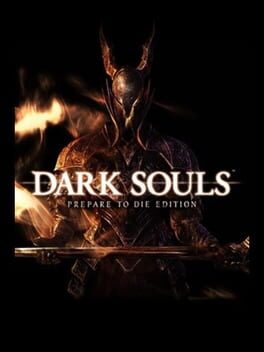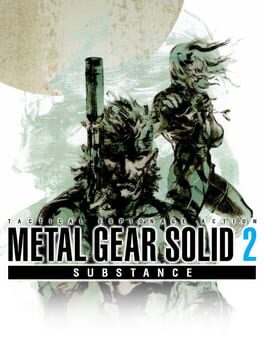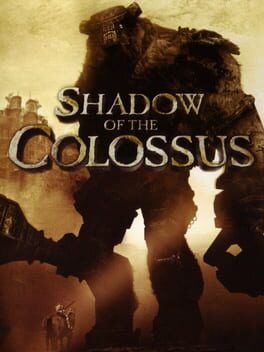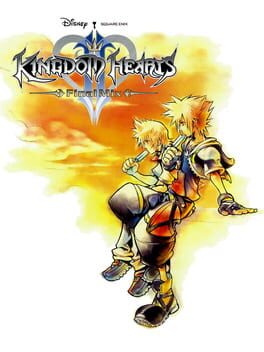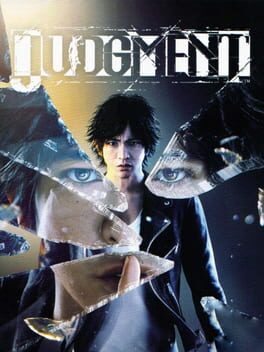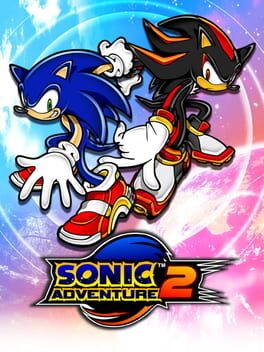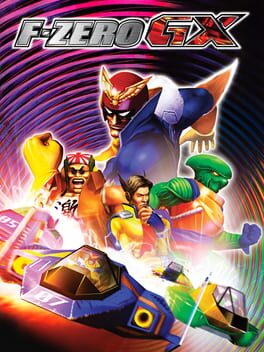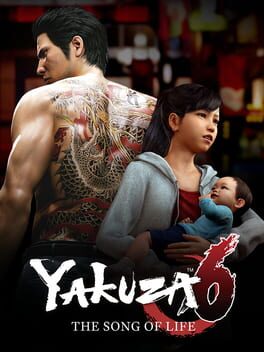Devixicus
Bio
I am fascinated by video games as an art form. To me the best games aren't necessarily the most polished or refined in execution, but those that set out to achieve things that are in some way unique. Polish can certainly make a game better but it cannot make up for lack of vision in my opinion.
5 stars is life changing, 4 stars a great time recommended to anyone, 3 stars was worth playing once, 2 stars a disappointment, and 1 star personally hurts my soul.
I've challenged myself to write about every game I complete. My reviews vary in length and sometimes I'll throw out quick jokes about games I don't care to review in full.
I am fascinated by video games as an art form. To me the best games aren't necessarily the most polished or refined in execution, but those that set out to achieve things that are in some way unique. Polish can certainly make a game better but it cannot make up for lack of vision in my opinion.
5 stars is life changing, 4 stars a great time recommended to anyone, 3 stars was worth playing once, 2 stars a disappointment, and 1 star personally hurts my soul.
I've challenged myself to write about every game I complete. My reviews vary in length and sometimes I'll throw out quick jokes about games I don't care to review in full.
Badges

Listed
Created 10+ public lists

Popular
Gained 15+ followers

GOTY '23
Participated in the 2023 Game of the Year Event

Well Written
Gained 10+ likes on a single review

Gone Gold
Received 5+ likes on a review while featured on the front page

1 Years of Service
Being part of the Backloggd community for 1 year

Busy Day
Journaled 5+ games in a single day

Gamer
Played 250+ games

On Schedule
Journaled games once a day for a week straight

Best Friends
Become mutual friends with at least 3 others

Pinged
Mentioned by another user

Noticed
Gained 3+ followers

Donor
Liked 50+ reviews / lists

Liked
Gained 10+ total review likes

Roadtrip
Voted for at least 3 features on the roadmap

N00b
Played 100+ games
Favorite Games
321
Total Games Played
015
Played in 2024
637
Games Backloggd
Recently Played See More
Recently Reviewed See More
The end of the Kiryu saga, The Song of Life, is an interesting specimen of a Like a Dragon game. It's the debut of the physics-based Dragon Engine, and there are shortcomings that are obvious from the difficulties they had in making Kamurocho at this new level of detail. However, while there are plenty of comparisons to make between this game and LaD 3, I actually prefer to think of this game as more similar to the original on PS2. It shares a self-serious story, focus on Kiryu as a flawed but honorable beat-em-up sort of guy, and a visceral but clunky combat system (and one that gets a bad wrap at times). It's my understanding that this game was developed alongside 0 and Kiwami, a throwback game to the first and a remake of said original in the same engine, and in my opinion, it shows that that first game was fresh in mind at the time this one was made.
I'll start on my favorite bit of this game - the storyline was phenomenal and brought the series back to the tone of the first game and the movies that inspired it. For the game's short length, it made the most of the drama of every boss fight and long battle, and the new cast of friendly characters felt more like a team and a family than usual for this franchise. The pacing was quite good compared to the lengthy and long winded nature of 5, though this game struggles with "belaboring the point" in dialogue much like 0 still did. My favorite element of this game's plot was the interrogation of Kiryu's tendency to fight to fix problems: he leaves a path of destruction every time he goes to Kamurocho or gets involved in crime business elsewhere, and this game is interested in challenging his ideals on that front unlike 4 and 5. It's refreshing to see this beloved character once again struggle with his nature of beating people up to get what he wants.
Though, as much as this game pays attention to the darker side of Kiryu and the criminal underworld, it's still in the era of goofy Yakuza hijinks. Once you take a step away from the main plot to do some side content, it's straight to the same wacky tone as 0's substories most of the time. Like a Dragon 0 rode a fine line between tonal shifts throughout the plot, and made room for that sort of silliness in the breaks you had between the drama in multiple ways. In 6, it's self-serious most of the time and it creates more intense whiplash than the series already had up to this point. You could say not to do side content, but rushing through the story in these games stunts your ability to level up and take on the challenges of the main story, especially on higher difficulties that demand a higher level of combat mastery than the standard or easy modes.
Speaking of leveling up, this game introduces a brand new system of experience types. There are five different types, and each is used to varying degrees in a long list of upgrades laid out in a similar fashion to the orbs system from LaD 4. I'll give credit that it's refreshing to once again have numerous choices on how to spend stats after 0 went the direction of a skill tree that basically normalized most playthroughs past the choice of which styles to level up first. However, this new system forces a lot of attention to go to side content, which is understandably frustrating for those who don't want to spend a good chunk of playtime managing a hunger system and looking for restaurants with balanced meals for the stats they want to upgrade.
Combat in this game was an interesting beast - it was refreshing and interesting in a way I did not expect. I knew going into this one that it was the first of the new engine, and therefore would likely have similar game feel and balancing issues as LaD 1 and 3 did. What I didn't expect was such a strong evolution of the original game's "pick things up and beat guys senseless" concept. Sure, 2 and its sequels had much better game feel and generally good combat compared to this game, but this is Like a Dragon. This is a series about Kiryu, a guy who's job was to beat people up to collect money for the Tojo Clan, and who can't seem to shake his urge to use his fists whenever serious problems arise in the darker side of his life. Much like that first game, the combat is very rough at the start and gets better as you scour the towns for things to do that give you experience and allow you to level up your stats and unlock abilities. If you are struggling to enjoy the combat in this game on a first playthrough, I encourage you to invest upgrades in experience boosts and a quicker hunger cycle to get stats and combat moves faster.
The game has two towns, Kamurocho and the new Onomichi. The classic city isn't quite in full form, with a good chunk of the top of the map completely inaccessible due to "construction". It's quite funny to see the developers actively admit that they couldn't build the whole city in time in-universe, though the construction barriers also randomly appear at times in the story to guide the player in linear segments. Onomichi is a much smaller map, which makes sense given it's a small town, though it's lacking in terms of restaurants and side games for a place that around half the game takes place in. That said, both locales look absolutely wonderful and the compromises are somewhat understandable given the achievements the team made in that department.
The ending of this game was certainly longer than it needed to be, but touched all the bases that the final full Kiryu game needed to. I felt emotionally satisfied by the final boss for the first time in the series since 2 or 3 (one day I'll explain what I mean by this) and the final act in general did a great job in tying everything together. Much like 4, this game is extremely twist heavy and I expect I'll get more disappointed with bits of the story as I spend more time away from this game. But as it stands, Like a Dragon 6 was more than I hoped it would be and I'm certainly glad I got around to playing it after taking a break from continuing the series for a long while.
I'll start on my favorite bit of this game - the storyline was phenomenal and brought the series back to the tone of the first game and the movies that inspired it. For the game's short length, it made the most of the drama of every boss fight and long battle, and the new cast of friendly characters felt more like a team and a family than usual for this franchise. The pacing was quite good compared to the lengthy and long winded nature of 5, though this game struggles with "belaboring the point" in dialogue much like 0 still did. My favorite element of this game's plot was the interrogation of Kiryu's tendency to fight to fix problems: he leaves a path of destruction every time he goes to Kamurocho or gets involved in crime business elsewhere, and this game is interested in challenging his ideals on that front unlike 4 and 5. It's refreshing to see this beloved character once again struggle with his nature of beating people up to get what he wants.
Though, as much as this game pays attention to the darker side of Kiryu and the criminal underworld, it's still in the era of goofy Yakuza hijinks. Once you take a step away from the main plot to do some side content, it's straight to the same wacky tone as 0's substories most of the time. Like a Dragon 0 rode a fine line between tonal shifts throughout the plot, and made room for that sort of silliness in the breaks you had between the drama in multiple ways. In 6, it's self-serious most of the time and it creates more intense whiplash than the series already had up to this point. You could say not to do side content, but rushing through the story in these games stunts your ability to level up and take on the challenges of the main story, especially on higher difficulties that demand a higher level of combat mastery than the standard or easy modes.
Speaking of leveling up, this game introduces a brand new system of experience types. There are five different types, and each is used to varying degrees in a long list of upgrades laid out in a similar fashion to the orbs system from LaD 4. I'll give credit that it's refreshing to once again have numerous choices on how to spend stats after 0 went the direction of a skill tree that basically normalized most playthroughs past the choice of which styles to level up first. However, this new system forces a lot of attention to go to side content, which is understandably frustrating for those who don't want to spend a good chunk of playtime managing a hunger system and looking for restaurants with balanced meals for the stats they want to upgrade.
Combat in this game was an interesting beast - it was refreshing and interesting in a way I did not expect. I knew going into this one that it was the first of the new engine, and therefore would likely have similar game feel and balancing issues as LaD 1 and 3 did. What I didn't expect was such a strong evolution of the original game's "pick things up and beat guys senseless" concept. Sure, 2 and its sequels had much better game feel and generally good combat compared to this game, but this is Like a Dragon. This is a series about Kiryu, a guy who's job was to beat people up to collect money for the Tojo Clan, and who can't seem to shake his urge to use his fists whenever serious problems arise in the darker side of his life. Much like that first game, the combat is very rough at the start and gets better as you scour the towns for things to do that give you experience and allow you to level up your stats and unlock abilities. If you are struggling to enjoy the combat in this game on a first playthrough, I encourage you to invest upgrades in experience boosts and a quicker hunger cycle to get stats and combat moves faster.
The game has two towns, Kamurocho and the new Onomichi. The classic city isn't quite in full form, with a good chunk of the top of the map completely inaccessible due to "construction". It's quite funny to see the developers actively admit that they couldn't build the whole city in time in-universe, though the construction barriers also randomly appear at times in the story to guide the player in linear segments. Onomichi is a much smaller map, which makes sense given it's a small town, though it's lacking in terms of restaurants and side games for a place that around half the game takes place in. That said, both locales look absolutely wonderful and the compromises are somewhat understandable given the achievements the team made in that department.
The ending of this game was certainly longer than it needed to be, but touched all the bases that the final full Kiryu game needed to. I felt emotionally satisfied by the final boss for the first time in the series since 2 or 3 (one day I'll explain what I mean by this) and the final act in general did a great job in tying everything together. Much like 4, this game is extremely twist heavy and I expect I'll get more disappointed with bits of the story as I spend more time away from this game. But as it stands, Like a Dragon 6 was more than I hoped it would be and I'm certainly glad I got around to playing it after taking a break from continuing the series for a long while.
I'm putting this game on hold for the time being since it's such a downer compared to it's predecessor, Sonic Adventure 2, for my tastes. There's a lot to like about this game, with great music and visuals tied to an interesting team-based gameplay style. However, I find the length of levels and the movement combine to make it very difficult to keep a good score. It's very easy to fall off the edge in this game, and given the character leveling system it ruins flow very easily through what feels like no fault of my own at times. Eventually I'll come back to this one, but likely after I 100% SA2 as I originally planned.
This review contains spoilers
The swan song of Sonic Team's time on Sega hardware: Sonic Adventure 2 is truly a one-of-a-kind game. While closest to Adventure 1 in styling and presentation, SA2 is really its own beast in terms of gameplay and storytelling. Instead of being an open-ended adventure RPG-like game, SA2 is instead a cutscene heavy arcade-style score attack action platformer. The combat is very simple just like classic Sonic, but much like Sonic the Hedgehog 2 did to the formula of Sonic 1, it expanded the challenge of the level design while fine tuning the controls to be more expressive. It pains me to imagine how great a true sequel to this game, like Sonic the Hedgehog 3 was to 2, could have been if it stuck to this trajectory.
It's hard to talk about anything other than the story in this game first, simply because the plot is so wonderfully written and presented compared to even the greatest 3D platformer stories around, both back then and today. This game's "story mode" is split between two long campaigns, the Hero Story and Dark Story, and a short finale similar to Super Sonic's in Adventure 1, simply titled "Last Story". Within each story you hop between three gameplay styles: Speed (Sonic and Shadow), Treasure Hunting (Knuckles and Rouge), and Shooting (Eggman and Tails). The plot is told chronologically from the perceptive from each team, with Dark Story starting slightly earlier as Eggman is the one to kick off the plot.
The Hero Story starts with Sonic escaping government capture for mysterious reasons, slowly revealed to be a doppelganger hedgehog stealing Chaos Emeralds for Eggman's plot to force the world into submission to his rule. Tails is quick to help break Sonic out of prison, and eventually Knuckles gets roped in as he is also looking to track the villains to find Master Emerald pieces that Rouge is after. But Eggman is not playing around like in Adventure 1, and he successfully blows up part of the moon in a threat to basically all world governments. So the team goes into space to chase him down to an abandoned space colony that he's using as his mega weapon, and the third act is just absolute bliss. Sonic, Tails, Knuckles, and Amy all get legendary character-defining scenes and this is by far my favorite portrayal of just about every character involved.
Dark Story, on the other hand, has a different appeal. While the heroes worked together and gave each other favors, all three dark members were secretly plotting against each other in some way. Eggman was the de facto ringleader for his boastful personality and legion of robots, but Shadow ultimately wanted to use him for his own goals of complete revenge against all of humanity. Rouge the Bat, my personal favorite of the lot, she assists the two of them just to get information and relay it to the President of the United States (a named and voiced character in this game). Many people make out Shadow to be this painfully edgy character, but his debut storyline is actually extremely well handled. He's been traumatized out of his short life of normalcy, and forced to take on false memories to fuel a desire for absolute destruction.
Speaking of Shadow's story, it crescendos at the Last Story, as both teams put aside their differences and create a temporary alliance to save the world from Gerald Robotnik's auto-crash sequence programmed into Space Colony ARK. As everyone else works together, Amy talks Shadow out of his confusion and he remembers Maria Robotnik, his only true friend, and what she truly said to him as she died instead of his false memory of her anger. In a moment of clarity, Shadow drops his entire mission to help the rest of the team stop the colony, eventually sacrificing himself to finish the job and warp them all back up to safety. The credits roll over the team meeting one last time and remembering the friend they all just lost, as Sonic cheers the rest up he says his final goodbye to someone he trusted the fate of the entire world to. The plot of this entire game wraps up so well and the ride is so fun, it's genuinely one of the strongest stories of any video game shooting for this age demographic.
In terms of gameplay, Sonic Adventure 2 is significantly more difficult and complex than its predecessor, SA1. Speed type characters are put in more precarious and action-packed scenarios than before, and the level design has expanded to become denser with alternate paths, secret nooks and crannies, and fancier setpieces. Though still simple to play and complete as a kid, the game now features a score grade system, in which you are evaluated for how fast you play, what tricks you pull off, finding secrets in the levels and taking optimal paths, et cetera. The gameplay might feel a bit less intuitive to start with, but with practice it becomes very expressive and fun. And with such a large number of levels and alternate objectives, there's always more to come back to here.
Treasure hunting, on the other hand, has expanded to become slower and more exploratory instead. Knuckles could easily find every emerald shard in the previous game in only a minute or two, but now the stages are greatly expanded in size and design variety. An unfortunate change is that the emerald detector now only gives one emerald's location at a time instead of all at once. However, it's not all bad as you get more familiar with the stage layouts and gradually get faster times for A ranks. Though, the final space stages for Knuckles and Rouge border on being a tad too large in my opinion, as casual playthroughs of the stages can easily pass 20 minutes which is rather tedious.
Shooting is an interesting case, as it's a continuation of the gameplay style e-102 Gamma had in the first Sonic Adventure. However, it's been retooled to fit a clunky Eggman mecha and then later to Tails' new mecha plane as well. Movement is a bit slower and more restrictive, and the focus is on racking up combos for points (and therefore achieve an A rank) as opposed to outpacing a level timer. It pains me that the movement took a hit as Gamma was actually quite nimble and fun to move with, though it does allow for some great new shooting gallery-style levels that take the concept further than Gamma ever could while he mostly reused Sonic stages. As far as platformer-shooter hybrids go, this one plays quite well and has great replay value, though it doesn't quite hold up against the PS2 Ratchet and Clank games. It has a similar feel to an on-rails shooter as well in the presentation of levels.
While those are the core gameplay styles, the game also has a couple more tricks up its sleeve. A couple highway driving levels are included, and they control more like a quick and dirty arcade racer than the kart racers most kids are familiar with. The controls are acceptable but rather strange feeling, but it's a short distraction for the most part. There's also the Chao Garden, which was greatly expanded from its limited options in the original Sonic Adventure. Chao can now have affinities for good or evil that lead them to becoming either Angel or Devil Chao, each with their own garden zone to hang out in. The races are longer and factor in more stats, and the VMU Chao Adventure game has also been greatly expanded in content (though it's still a Tamagotchi clone that will give you bad luck at random).
Chao raising is a long term process that takes longer than a full playthrough of the story mode, which encourages replaying the action stages for more animal buddies and chaos drives to boost stats for races. And the more you play the stages, the better you get and the higher your ranks trend. Every stage also has four side objectives, which also give letter ranks but only for completion time. All of this combined makes this game downright addicting and very hard to put down. Sonic Adventure 1 was a game that had me craving more, but Adventure 2 delivers on content just on the level of how replayable just about every part of it is. I was looking to get 100% completion on this playthrough but technical difficulties lead me to drop the task before finishing it. I'll give it another go one day, perhaps on Steam or with a more consistently working Dreamcast.
One thing I first got to appreciate with this replay has been the original Japanese voice acting, which is just as wonderful as in the previous game and is better timed to the cutscenes' animation than the notoriously poorly paced English dub. The Japanese cast really nailed every role out of the gate, and this game solidified their sound in a story more serious than ever before. Newcomers Shadow and Rouge have standout performances here just as they do in English. And luckily, both the American and Japanese discs are identical and include dual audio so you can choose which track you like more or switch as you feel like it. Just a head up: the Japanese version is much, much, much cheaper.
On the subject of the English cast, this is Ryan Drummond's best work on the character by far. Tails' voice (Connor Bringas, family member of previous Tails actor Corey Bringas) is an improvement, and Scott Drier as Knuckles is a different vibe but fits the character in this story extremely well. Deem Bristow's Eggman is an absolute treat and he's just lovely here as always. Much like almost every other character, Shadow (David Humphrey) and Rouge (Lani Minella) have this game's voices in my head and never the replacement actors they've had over the years. Jennifer Douillard as Amy isn't popular but I personally think she does a great job portraying the character's young naivety. The voice direction here is a lot more solid than before, with the drama coming out much more naturally as the characters emote more properly for their given situations. And given the strong cutscene direction, it all adds to a wonderful presentation, even as characters talk over each other unusually at points.
Of course, we cannot forget this game's absolutely legendary soundtrack. Running with the rock-electronic fusion sound Sonic Adventure is known for, SA2 expands the sound by giving each character their own distinct flavor of music. Sonic's stages are action-packed rock songs, Tails' more complex and on the progressive and synth-heavy side. Knuckles, on the other hand, has exquisite hip hop backing every stage for the slower nature of the gameplay. On the dark side, Eggman's tracks start dipping into metal sensibilities with heavy and menacing guitar and bass riffs. Shadow's music is mostly from an electronic post-grunge angle with some punk rock to spice things up. Finally, Rouge jams out to smooth and light jazz, perfect for the classy spy archetype she fits in the story.
Finishing thoughts: This was the final truly coherent Sonic the Hedgehog game. From Sonic 1 all the way until here, there was a clear progression and logical thread to the overarching series storyline. Some may feel Adventure was a grand departure from the classics, but in my opinion the jump isn't all that large. Sonic and friends simply moved onto life closer to people, and they factor more into Eggman's plots than before as he now wants to rule over people as well as nature. And a hollywood-style blockbuster story like this was a perfect capstone to Sonic Team's greatest years in my opinion. The hedgehog lives on in our hearts and continues to put out great games from time to time, but he will never be the same as that starry eyed hero who left us with the words "Sayonara, Shadow the Hedgehog".
It's hard to talk about anything other than the story in this game first, simply because the plot is so wonderfully written and presented compared to even the greatest 3D platformer stories around, both back then and today. This game's "story mode" is split between two long campaigns, the Hero Story and Dark Story, and a short finale similar to Super Sonic's in Adventure 1, simply titled "Last Story". Within each story you hop between three gameplay styles: Speed (Sonic and Shadow), Treasure Hunting (Knuckles and Rouge), and Shooting (Eggman and Tails). The plot is told chronologically from the perceptive from each team, with Dark Story starting slightly earlier as Eggman is the one to kick off the plot.
The Hero Story starts with Sonic escaping government capture for mysterious reasons, slowly revealed to be a doppelganger hedgehog stealing Chaos Emeralds for Eggman's plot to force the world into submission to his rule. Tails is quick to help break Sonic out of prison, and eventually Knuckles gets roped in as he is also looking to track the villains to find Master Emerald pieces that Rouge is after. But Eggman is not playing around like in Adventure 1, and he successfully blows up part of the moon in a threat to basically all world governments. So the team goes into space to chase him down to an abandoned space colony that he's using as his mega weapon, and the third act is just absolute bliss. Sonic, Tails, Knuckles, and Amy all get legendary character-defining scenes and this is by far my favorite portrayal of just about every character involved.
Dark Story, on the other hand, has a different appeal. While the heroes worked together and gave each other favors, all three dark members were secretly plotting against each other in some way. Eggman was the de facto ringleader for his boastful personality and legion of robots, but Shadow ultimately wanted to use him for his own goals of complete revenge against all of humanity. Rouge the Bat, my personal favorite of the lot, she assists the two of them just to get information and relay it to the President of the United States (a named and voiced character in this game). Many people make out Shadow to be this painfully edgy character, but his debut storyline is actually extremely well handled. He's been traumatized out of his short life of normalcy, and forced to take on false memories to fuel a desire for absolute destruction.
Speaking of Shadow's story, it crescendos at the Last Story, as both teams put aside their differences and create a temporary alliance to save the world from Gerald Robotnik's auto-crash sequence programmed into Space Colony ARK. As everyone else works together, Amy talks Shadow out of his confusion and he remembers Maria Robotnik, his only true friend, and what she truly said to him as she died instead of his false memory of her anger. In a moment of clarity, Shadow drops his entire mission to help the rest of the team stop the colony, eventually sacrificing himself to finish the job and warp them all back up to safety. The credits roll over the team meeting one last time and remembering the friend they all just lost, as Sonic cheers the rest up he says his final goodbye to someone he trusted the fate of the entire world to. The plot of this entire game wraps up so well and the ride is so fun, it's genuinely one of the strongest stories of any video game shooting for this age demographic.
In terms of gameplay, Sonic Adventure 2 is significantly more difficult and complex than its predecessor, SA1. Speed type characters are put in more precarious and action-packed scenarios than before, and the level design has expanded to become denser with alternate paths, secret nooks and crannies, and fancier setpieces. Though still simple to play and complete as a kid, the game now features a score grade system, in which you are evaluated for how fast you play, what tricks you pull off, finding secrets in the levels and taking optimal paths, et cetera. The gameplay might feel a bit less intuitive to start with, but with practice it becomes very expressive and fun. And with such a large number of levels and alternate objectives, there's always more to come back to here.
Treasure hunting, on the other hand, has expanded to become slower and more exploratory instead. Knuckles could easily find every emerald shard in the previous game in only a minute or two, but now the stages are greatly expanded in size and design variety. An unfortunate change is that the emerald detector now only gives one emerald's location at a time instead of all at once. However, it's not all bad as you get more familiar with the stage layouts and gradually get faster times for A ranks. Though, the final space stages for Knuckles and Rouge border on being a tad too large in my opinion, as casual playthroughs of the stages can easily pass 20 minutes which is rather tedious.
Shooting is an interesting case, as it's a continuation of the gameplay style e-102 Gamma had in the first Sonic Adventure. However, it's been retooled to fit a clunky Eggman mecha and then later to Tails' new mecha plane as well. Movement is a bit slower and more restrictive, and the focus is on racking up combos for points (and therefore achieve an A rank) as opposed to outpacing a level timer. It pains me that the movement took a hit as Gamma was actually quite nimble and fun to move with, though it does allow for some great new shooting gallery-style levels that take the concept further than Gamma ever could while he mostly reused Sonic stages. As far as platformer-shooter hybrids go, this one plays quite well and has great replay value, though it doesn't quite hold up against the PS2 Ratchet and Clank games. It has a similar feel to an on-rails shooter as well in the presentation of levels.
While those are the core gameplay styles, the game also has a couple more tricks up its sleeve. A couple highway driving levels are included, and they control more like a quick and dirty arcade racer than the kart racers most kids are familiar with. The controls are acceptable but rather strange feeling, but it's a short distraction for the most part. There's also the Chao Garden, which was greatly expanded from its limited options in the original Sonic Adventure. Chao can now have affinities for good or evil that lead them to becoming either Angel or Devil Chao, each with their own garden zone to hang out in. The races are longer and factor in more stats, and the VMU Chao Adventure game has also been greatly expanded in content (though it's still a Tamagotchi clone that will give you bad luck at random).
Chao raising is a long term process that takes longer than a full playthrough of the story mode, which encourages replaying the action stages for more animal buddies and chaos drives to boost stats for races. And the more you play the stages, the better you get and the higher your ranks trend. Every stage also has four side objectives, which also give letter ranks but only for completion time. All of this combined makes this game downright addicting and very hard to put down. Sonic Adventure 1 was a game that had me craving more, but Adventure 2 delivers on content just on the level of how replayable just about every part of it is. I was looking to get 100% completion on this playthrough but technical difficulties lead me to drop the task before finishing it. I'll give it another go one day, perhaps on Steam or with a more consistently working Dreamcast.
One thing I first got to appreciate with this replay has been the original Japanese voice acting, which is just as wonderful as in the previous game and is better timed to the cutscenes' animation than the notoriously poorly paced English dub. The Japanese cast really nailed every role out of the gate, and this game solidified their sound in a story more serious than ever before. Newcomers Shadow and Rouge have standout performances here just as they do in English. And luckily, both the American and Japanese discs are identical and include dual audio so you can choose which track you like more or switch as you feel like it. Just a head up: the Japanese version is much, much, much cheaper.
On the subject of the English cast, this is Ryan Drummond's best work on the character by far. Tails' voice (Connor Bringas, family member of previous Tails actor Corey Bringas) is an improvement, and Scott Drier as Knuckles is a different vibe but fits the character in this story extremely well. Deem Bristow's Eggman is an absolute treat and he's just lovely here as always. Much like almost every other character, Shadow (David Humphrey) and Rouge (Lani Minella) have this game's voices in my head and never the replacement actors they've had over the years. Jennifer Douillard as Amy isn't popular but I personally think she does a great job portraying the character's young naivety. The voice direction here is a lot more solid than before, with the drama coming out much more naturally as the characters emote more properly for their given situations. And given the strong cutscene direction, it all adds to a wonderful presentation, even as characters talk over each other unusually at points.
Of course, we cannot forget this game's absolutely legendary soundtrack. Running with the rock-electronic fusion sound Sonic Adventure is known for, SA2 expands the sound by giving each character their own distinct flavor of music. Sonic's stages are action-packed rock songs, Tails' more complex and on the progressive and synth-heavy side. Knuckles, on the other hand, has exquisite hip hop backing every stage for the slower nature of the gameplay. On the dark side, Eggman's tracks start dipping into metal sensibilities with heavy and menacing guitar and bass riffs. Shadow's music is mostly from an electronic post-grunge angle with some punk rock to spice things up. Finally, Rouge jams out to smooth and light jazz, perfect for the classy spy archetype she fits in the story.
Finishing thoughts: This was the final truly coherent Sonic the Hedgehog game. From Sonic 1 all the way until here, there was a clear progression and logical thread to the overarching series storyline. Some may feel Adventure was a grand departure from the classics, but in my opinion the jump isn't all that large. Sonic and friends simply moved onto life closer to people, and they factor more into Eggman's plots than before as he now wants to rule over people as well as nature. And a hollywood-style blockbuster story like this was a perfect capstone to Sonic Team's greatest years in my opinion. The hedgehog lives on in our hearts and continues to put out great games from time to time, but he will never be the same as that starry eyed hero who left us with the words "Sayonara, Shadow the Hedgehog".

